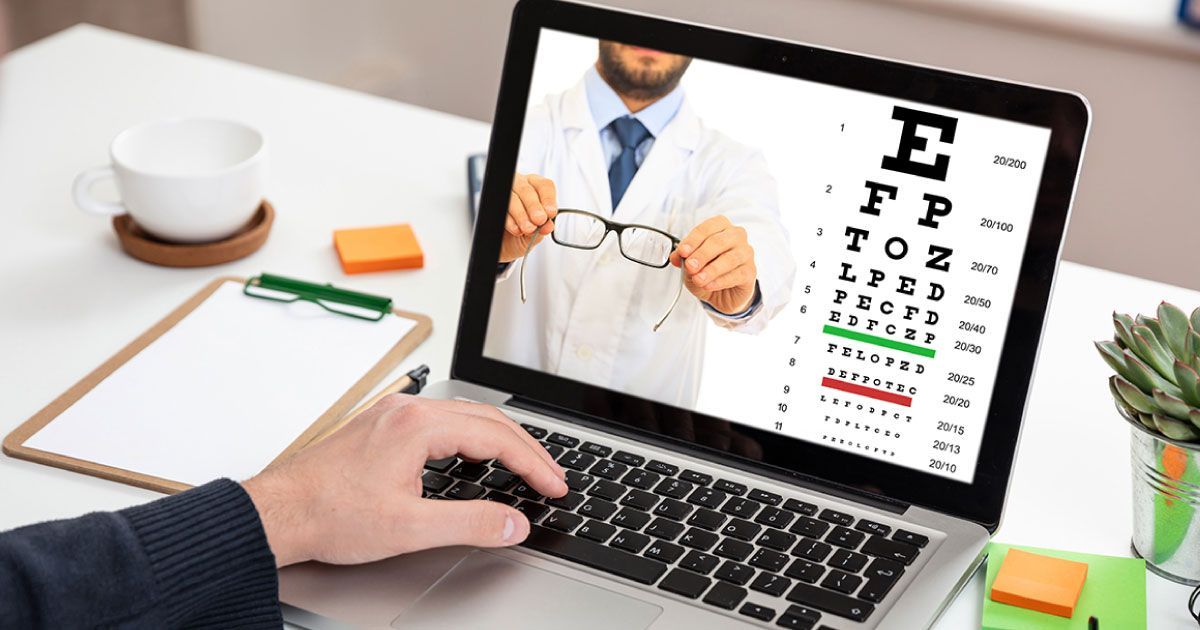Are Online Eye Exams Accurate? Why In-Person Eye Exams Are Essential

Reading time: 5 minutes
In today’s digital world, convenience is everything. From virtual doctor visits to online shopping, technology has streamlined many aspects of life - including eye exams. Online eye exams promise a quick and easy way to check your vision and update your prescription, all from the comfort of home. But are they truly effective? While they may seem like a modern solution, online eye exams fall short in providing the level of care and accuracy that an in-person comprehensive eye exam offers.
What Is an Online Eye Exam?
Online eye exams are digital tests designed to assess visual acuity (how well you see) and, in some cases, provide a prescription for glasses or contact lenses. These tests typically involve reading letters from a screen and answering basic questions about your vision. However, online eye exams lack the tools and expertise needed to fully assess your eye health and overall well-being.
How Online Eye Exams Differ from Comprehensive Eye Exams
A comprehensive eye exam, performed by an optometrist or ophthalmologist, evaluates much more than just how well you see. It includes:
- A thorough eye health assessment: Checking for conditions such as glaucoma, cataracts, macular degeneration, diabetic eye disease, and retinal disorders—many of which can develop without noticeable symptoms.
- Retinal imaging & eye pressure testing: Detecting early signs of vision-threatening diseases. Learn more about our diagnostic equipment technology here.
- A precise, customized prescription: Unlike online exams, an in-person exam accounts for astigmatism, eye coordination, depth perception, and focusing abilities to provide a truly accurate prescription.
- Evaluation of overall health: Many systemic diseases, such as diabetes, hypertension, and even brain tumors, can first show symptoms in the eyes - something an online test cannot detect.
To learn more about the diagnostic tests conducted during eye exams at Urban Optiks Optometry, click here.
The Myths vs. Reality of Online Eye Exams
Myth: Online eye exams are just as accurate as in-person exams.
Reality: Online tests are limited and cannot account for subtle vision changes or underlying health issues that could affect your eyesight.
Myth: They can replace a full eye health check.
Reality: Online exams only test vision clarity. They don’t check for serious conditions like glaucoma or retinal disease, which require specialized equipment and expertise.
Myth: Online exams provide reliable prescriptions.
Reality: Screen-based testing can lead to inaccurate prescriptions. Poorly calibrated screens, lighting conditions, and user error can result in an incorrect prescription, leading to eye strain, headaches, and discomfort.
Myth: Online eye exams save money in the long run.
Reality: While an online test may seem cheaper upfront, inaccurate prescriptions or undiagnosed eye conditions can lead to more costly treatments or frequent prescription changes down the line. A comprehensive in-person exam helps prevent vision problems before they become costly issues.
Myth: They’re good enough for contact lens prescriptions.
Reality: Contact lens prescriptions require precise measurements of your eye's shape, corneal health, and tear production—something no online test can accurately measure. An improper fit can lead to eye infections, discomfort, and even long-term damage.
Myth: If I have no symptoms, I don’t need a full eye exam.
Reality: Many serious eye diseases, like glaucoma, macular degeneration, and diabetic retinopathy, develop silently without noticeable symptoms in the early stages. By the time you notice vision loss, permanent damage has already occurred. Only an in-person exam can detect these conditions early and help preserve your eyesight.
Myth: Online exams are approved by eye care professionals.
Reality: Most optometrists and ophthalmologists do not recommend online exams as a substitute for in-person visits. While they can be a convenient tool for basic vision screenings, they lack the accuracy, depth, and professional oversight needed for true eye health assessments.
Other Key Tips - What Online Eye Exams Can’t Provide
- No Personalized Care: Eye care isn’t one-size-fits-all. An in-person exam allows your optometrist to provide personalized advice based on your specific health needs, lifestyle, and vision demands—something an online test simply can’t do.
- No Follow-Up for Issues: If an online test detects a potential problem or if you have concerns, there’s no built-in follow-up care. In contrast, an in-person visit ensures you receive expert guidance, treatment options, and ongoing monitoring for any issues that arise.
- No Detection of Hidden Health Conditions: Serious health problems like high blood pressure, diabetes, and even early signs of neurological conditions can be spotted during an eye exam. Online exams only assess vision and miss these crucial warning signs.
Want to dive a little deeper? Check out this blog from the American Optometric Association to see how you get the full picture of your health with an annual comprehensive eye exam.
The Takeaway
While online eye exams may seem convenient, they are no replacement for a comprehensive exam by a licensed optometrist. You miss out on critical health checks, personalized care, and expert guidance that could significantly impact your overall health.
Don’t take risks with your vision—schedule an in-person eye exam at Urban Optiks Optometry today and experience the highest standard of eye care.
Share this blog post on social or with a friend:
The information provided in this article is intended for general knowledge and educational purposes only and should not be construed as medical advice. It is strongly recommended to consult with an eye care professional for personalized recommendations and guidance regarding your individual needs and eye health concerns.
All of Urban Optiks Optometry's blog posts and articles contain information carefully curated from openly sourced materials available in the public domain. We strive to ensure the accuracy and relevance of the information provided. For a comprehensive understanding of our practices and to read our full disclosure statement, please click here.


















